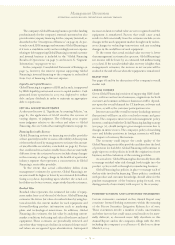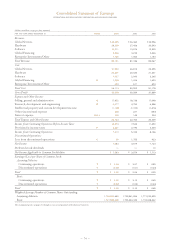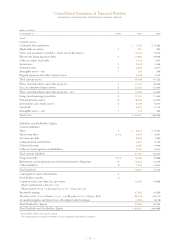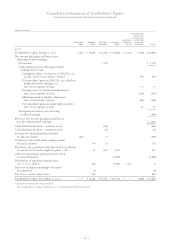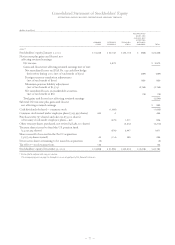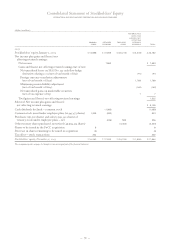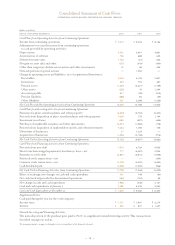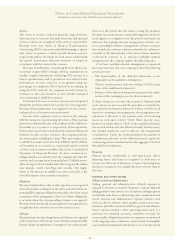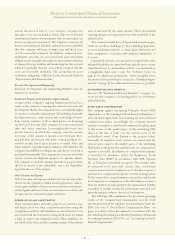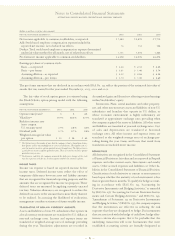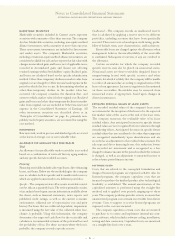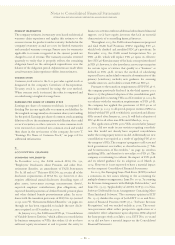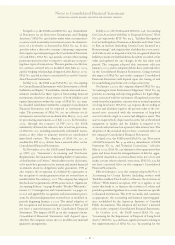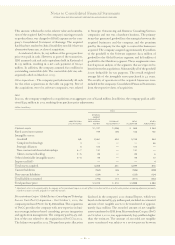IBM 2003 Annual Report Download - page 82
Download and view the complete annual report
Please find page 82 of the 2003 IBM annual report below. You can navigate through the pages in the report by either clicking on the pages listed below, or by using the keyword search tool below to find specific information within the annual report.
arrangement, the product has been shipped or the services
have been provided to the client, the sales price is fixed or
determinable, and collectibility is reasonably assured. The
company reduces revenue for estimated client returns and
other allowances. In addition to the aforementioned general
policy, the following are the specific revenue recognition poli-
cies for multiple-element arrangements and for each major
category of revenue.
Multiple-Element Arrangements
The company enters into transactions that represent multiple-
element arrangements, which may include any combination
of services, software, hardware and financing. Multiple-
element arrangements are assessed to determine whether
they can be separated into more than one unit of accounting.
Amultiple-element arrangement is separated into more than
one unit of accounting if all of the following criteria are met.
•The delivered item(s) has value to the client on a stand-
alone basis.
•There is objective and reliable evidence of the fair value of
the undelivered item(s).
•If the arrangement includes a general right of return relative
to the delivered item(s), delivery or performance of the
undelivered item(s) is considered probable and substan-
tially in the control of the company.
If these criteria are not met, then revenue is deferred until
such criteria are met or until the period(s) over which the
last undelivered element is delivered. If there is objective
and reliable evidence of fair value for all units of accounting
in an arrangement, the arrangement consideration is allo-
cated to the separate units of accounting based on each unit’s
relative fair value. There may be cases, however, in which
there is objective and reliable evidence of fair value of the
undelivered item(s) but no such evidence for the delivered
item(s). In those cases, the residual method is used to allocate
the arrangement consideration. Under the residual method,
the amount of consideration allocated to the delivered item(s)
equals the total arrangement consideration less the aggregate
fair value of the undelivered item(s). The revenue policies
described below are then applied to each unit of accounting.
For any non-software products that are in a multiple-
element arrangement whereby the software products in the
arrangement are not essential to the functionality of the
non-software items, the guidance for multiple-element
arrangements described above apply to the non-software
items. If, however, the software products are essential to the
functionality of the non-software items, then the guidance
described in Software on page 81 should be applied for
purposes of separating and allocating consideration to the
software and non-software items.
Notes to Consolidated Financial Statements
INTERNATIONAL BUSINESS MACHINES CORPORATION AND SUBSIDIARY COMPANIES
80
A
significant accounting policies
BASIS OF PRESENTATION
On December 31, 2002, the company sold its hard disk drive
(HDD) business to Hitachi, Ltd. (Hitachi). See note C,
“A cquisitions/Divestitures,” on pages 89 to 92. The HDD
business was part of the company’s Technology Group
reporting segment. The HDD business was accounted for as
a discontinued operation under generally accepted account-
ing principles (GAAP) and therefore, the HDD results of
operations and cash flows have been removed from the
company’s results of continuing operations and cash flows
for all periods presented in this document. The financial
results reported as discontinued operations include the
external original equipment manufacturer (OEM) HDD
business and charges related to HDDs used in the company’s
eServer and Storage products that were reported in the
Technology Group segment. The discontinued operations
results do not reflect HDD shipments to the company’s
internal customers.
PRINCIPLES OF CONSOLIDATION
The Consolidated Financial Statements include the accounts
of International Business Machines Corporation (IBM) and
its controlled subsidiary companies, which in general are
majority owned. The accounts of variable interest entities
(VIEs) as defined by the Financial Accounting Standards
Board’s (FASB) Interpretation No. 46 (FIN 46) and related
interpretations (see note B, “Accounting Changes,” on page
86), created after January 31, 2003, are included in the
Consolidated Financial Statements. Investments in business
entities in which the company does not have control, but has
the ability to exercise significant influence over operating
and financial policies (generally 20-50 percent ownership),
are accounted for by the equity method. Other investments
are accounted for by the cost method. The accounting policy
for other investments in securities is described on page 85
within “Marketable Securities.”
USE OF ESTIMATES
The preparation of Consolidated Financial Statements in
conformity with GAAP requires management to make
estimates and assumptions that affect the amounts that are
reported in the Consolidated Financial Statements and
accompanying disclosures. Although these estimates are
based on management’s best knowledge of current events
and actions that the company may undertake in the future,
actual results may be different from the estimates.
REVENUE
The company recognizes revenue when it is realized or realiz-
able and earned. The company considers revenue realized or
realizable and earned when it has persuasive evidence of an





